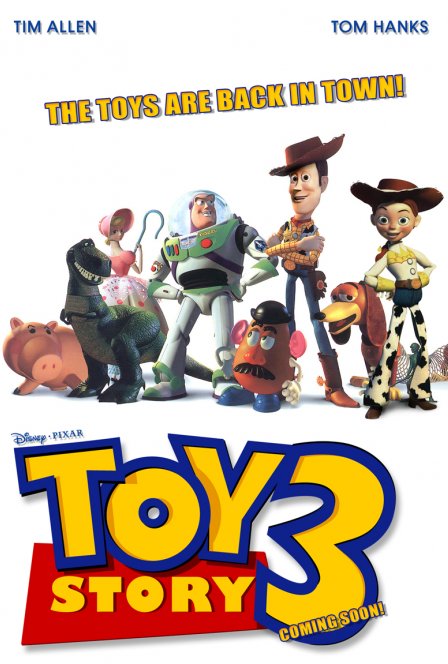I make no secret of my adoration for Pixar Animation Studio. Be it from an academic perspective or a humanitarian one, I’ve been singing the studios’ praises publicly for a couple years and privately for as long as I can remember. However, rather than spend time waxing nostalgic over my first experience seeing Toy Story as a seven year old or drawing parallels between Pixar’s developmental progress as a studio and the thematic content of its filmography, I will instead simply say this: before Toy Story 3, I hadn’t had so much fun at a movie in years. From its opening setpiece, a classic Western with an increasingly hysterical modern tilt, to the shards of raw emotion that stick out with greater clarity than any 3D projection, Toy Story 3 is as remarkable a film as it is a delightful night out with friends and family.
Magnificently dovetailing with Pixar’s recent output, the film is equal parts prison drama, three-hankie weepie, and family comedy, blending the emotional reach of Up with the theatricality of WALL·E. Beginning as a comedy of errors with the ensemble of Toys being mistakenly thrown out rather than extradited to the green zone of the family attic, Toy Story 3 initially offers much space for the audience to wonder whether the film won’t be the adrenal adventure of its predecessors, but perhaps a small, contemplative film: more Bergman than Spielberg. Knowing it’s a kid’s film, it’s still not totally unreasonable to imagine Pixar pulling off such a trick. Considering the existential thoughtfulness of Up, the near avante-garde visual texture of WALL·E, the New Wave-ish glory of Ratatouille (not to mention the critical and commercial success of all three), Pixar was primed to make a film that further transcended the static notion of modern children’s films. The manifest of this possibility is the complex ideological debate of individual ingenuity vs. group integrity that surges throughout the first act. The film builds up to Marxist fervor at the utopian day care center, which the Toys (with the exception of Woody) choose over the return to a position of subordination to a benevolent ruler (the 17-year-old Andy) who has all but forgotten their existence. For a short time, it almost looks like Toy Story 3 is set to become a heady dystopian fever dream of soviet proportions.
What happens instead is far more fitting and much less pretentious. The contention between the individual and the community continues but as a subtext rather than a full-blown theme. The day care center is revealed to be a feudal hierarchy. At its apex is misanthrope Lotso Bear, who parades as southern gentleman while his cane and limp evoke the tyranny of Orson Welles’ crooked police detective in A Touch of Evil. The day care is divided between the heavenly Butterfly Room and the hellish nightmare of the Caterpillar Room (characterized by a deft parody of the terrifying camera work in Requiem for a Dream). When Buzz Lightyear attempts to reason with kingpin Lotso, he discovers the horrific extent to which Lotso rules his toy kingdom. He is “brainwashed” and returns to the Toys as a foot soldier of injustice, holding his former comrades in captivity. Woody returns out solidarity with his fellow Toys and arranges a rescue mission that becomes the central, astounding setpiece of the film’s second half.
This second half, which prominently features the film’s most impressive narrative twists, sublimely realized emotional landscapes, visual gags (I just about died laughing at Mr. Tortilla Head), and one liners, fully overpowers the social subtext of the film’s first half. Which, to be honest, is fine. While adults and critics alike will no doubt salivate at Pixar’s by-turns comic and terrifyingly accurate reimagining of captivity narratives, prison dramas, and classic horror films, the task of paying it back to the old masters who inform and influence their work has always been second to Pixar Studio’s desire to create new, original works. After all, how often does a film bring together ideological dialectics and stunning visual invention all while de-vilifying commercialist capitalism? By my count, three.
For a film that accomplishes so much from a studio that has been at the peak of its creative power since 2007, Toy Story 3’s final sequences are something of a swan song to the cinema of our lives. A handful of us have had the honor of growing up alongside Pixar. If Andy’s handing off his “friends” airs on the side of sentimentality… well… that’s just fine. It is rare in cinema that such a passionate and heartfelt relationship should spring up between not only viewers and a single film, but viewers and an entire studio’s creative outpouring. But such is this case with Pixar. Although their films never fail to be as dynamic as anything the art house world has to offer, it always feels like the folks behind Pixar are gently consoling us. They are insisting that it’s okay to hold on to certain things forever. The imperative to grow up, to become an adult, can and should coexist symbiotically with the need to remain, at least in part, a child. If we could all hold onto our sense of childlike wonder and imagination the way Pixar’s team has, then Toy Story 3 wouldn’t just be the prized object we celebrate fleetingly, but just one more enchanting plaything in the toy box of our endless youth.

